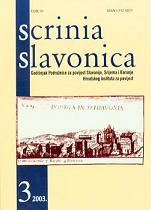Prilog srednjovjekovnoj topografiji i hidrografiji psunjsko-papučkog kraja
A contribution to the medieval topography and hydrography of the Psunj and Papuk area
Author(s): Stanko AndrićSubject(s): History
Published by: Hrvatski institut za povijest
Keywords: Historical topography and hydrography; 13th and 14th centuries; Ilova; Pakra; Bijela (rivers); Papuk and Psunj (mountains); Grabovo; Rudina; abbeys
Summary/Abstract: Research on the medieval topography of Slavonia is a job far from being finished, in spite of a sequence of valuable contributions to this field by various authors. A century ago the whole eastern half of the area between the Drava and the Sava rivers was carefully studied by Dezsõ Csánki, whose contribution, a part of his renowned five-volume handbook of historical geography of medieval Hungary, remains fundamental. Csánki’s work was later pursued, mostly with focus on more limited portions of the region, notably by Ðuro Szabo, Juraj Ćuk, Stjepan Pavičić, Josip Buturac, György Györffy and Pál Engel. Tivadar Ortvay and later Ernst Dickenmann studied the more specific subject of the area’s hydrography and hydronymy. Csánki was first to clarify some peculiar features of the fluvial system in the south-eastern part of the medieval county of Križevci (Kőrös), i.e. in the south-western part of modern Slavonia. He identified medieval Pukur (or Peker), Pukruc (or Pekrec) and Szaplonca (< *Stblbpnica or *Slapnica) with modern Bijela, Pakra and Ilova respectively. Unlike the modern perception, medieval population regarded Pukur (Bijela) as the most important river of the area and a direct tributary of the Sava. Both the Szaplonca (Ilova) and the Pukruc (Pakra) were perceived as the Pukur’s tributaries.The medieval priority of the Pukur over the Pukruc is also reflected in the latter’s name being (Slavic) diminutive of the first; but the Pukruc (Pakra) cannot be identified, as Ortvay implied, with an arm of the Pukur called in some sources Aszúpukur ‘Dry Pukur’. An evidence supporting Csánki’s identifications of the Pukur and the Pukruc is found in two charters dealing respectively with lands of the Benedictine monasteries of Grabovo (Garáb) and Rudina. The first charter, dating from 1234, validates the sale of the Grabovo abbey’s estate called Zelbarouna or Szélborona (meaning intriguingly ‘border barrier’ or ‘border fence’). The estate was situated on the southwestern slopes of the Papuk mountain, between the Pukur (Bijela) in the north and a ridge called Kamena brda (‘Stone Hills’) in the south. The second charter, from 1349, cancels the leasing of two estates of the abbey of Rudina which were situated on either side of the upper Pukruc (Pakra) stream. The estate on the northern (right) side of the stream, called Zelna, had the same Kamena brda ridge on its northern boundary. This makes possible to identify Kamena brda as (a part of) the present-day Ravna gora, a hill-range separated from the neighbouring Papuk and Psunj mountains by the upper courses of the Bijela and the Pakra respectively. This reconstruction corroborates Csánki’s conclusions about the medieval hydrography of the area, and should facilitate further historical-topographical exploration of the Slavonian highlands.
Journal: Scrinia Slavonica
- Issue Year: 2003
- Issue No: 3
- Page Range: 70-94
- Page Count: 25
- Language: Croatian

